Those who have been retired far longer than my wife and I have been will understand what I am about to say next.
I am having a bit of difficulty understanding that the term “weekend” no longer is relevant to either of us.
We have embarked on a two-week sojourn that will begin in Amarillo. We’ll pull our fifth wheel south to San Angelo, then to the Hill Country, down to the Golden Triangle, then to New Orleans, to Shreveport and then home.
What’s different about this particular journey is that we’ll be parking our RV in a new storage place just around the corner and down the street from our new home in Princeton, Texas.
Which brings me to the “weekend” point.
My wife has reminded me that we’ll be able to grab our fifth wheel and take it on short trips to any of the numerous state parks surrounding us in Collin County.
“Sure thing,” I have said. “We can plan a weekend trip.” She laughs out loud at me. “No-o-o-o! Don’t you get it? We don’t have to wait for the weekend,” she responds. “We can go in the middle of the week. No crowds. Others will be working.”
Well, duhhh.
I just will need to keep all of that in mind once we get a wild hair and want to haul our fifth wheel out of storage and head out for some quiet time in the woods, or next to a lake.
I’m getting the hang of this retirement thing. Every now and then, though, I need a knock on the noggin to be reminded that weekends are for working folks.



